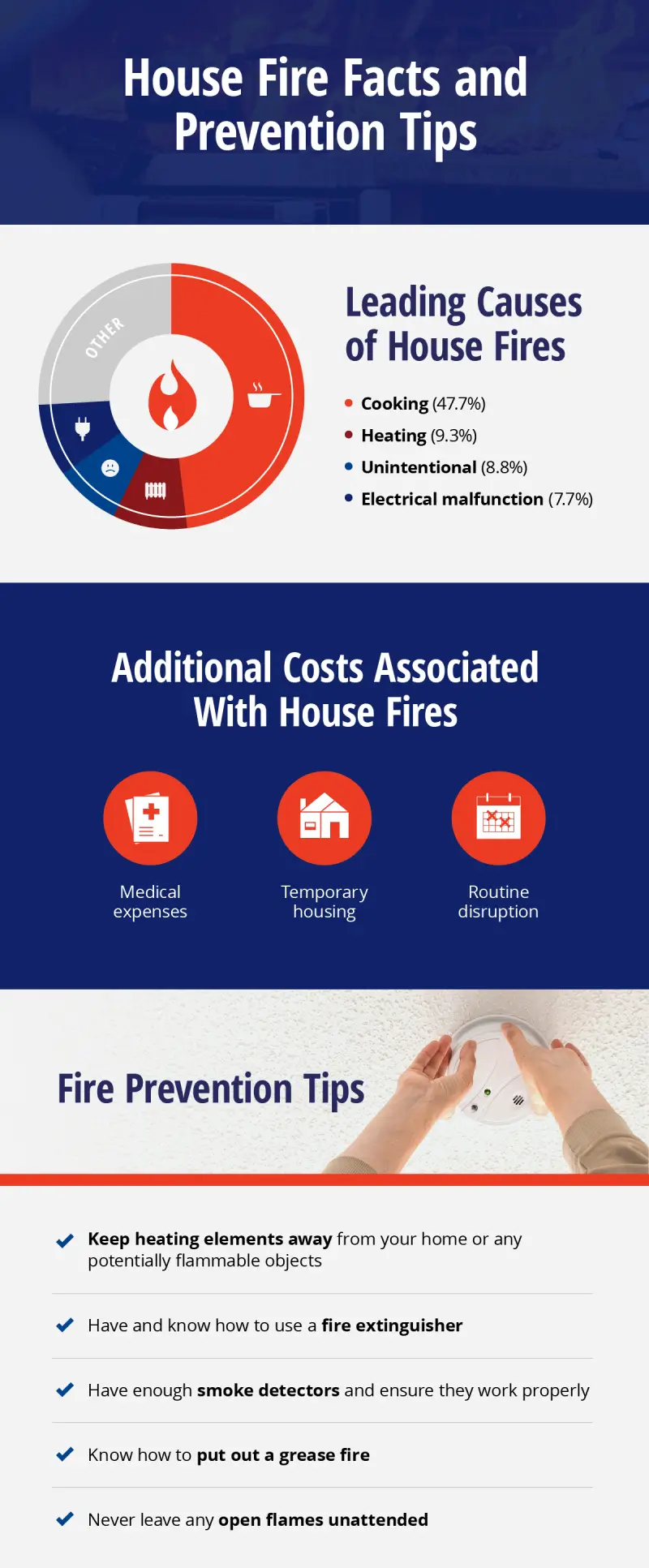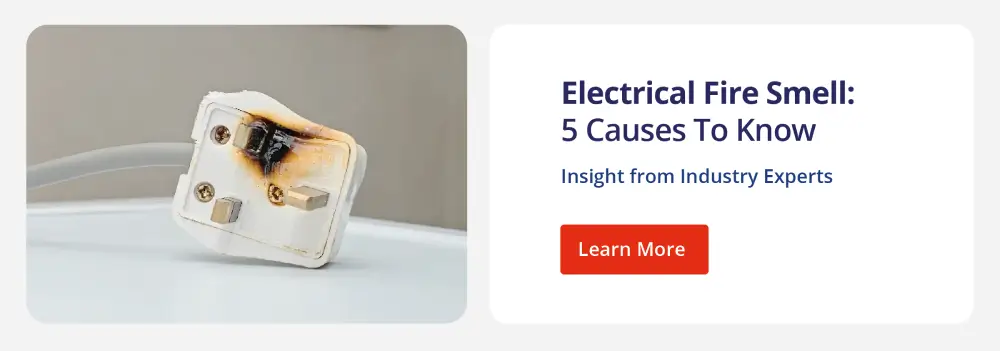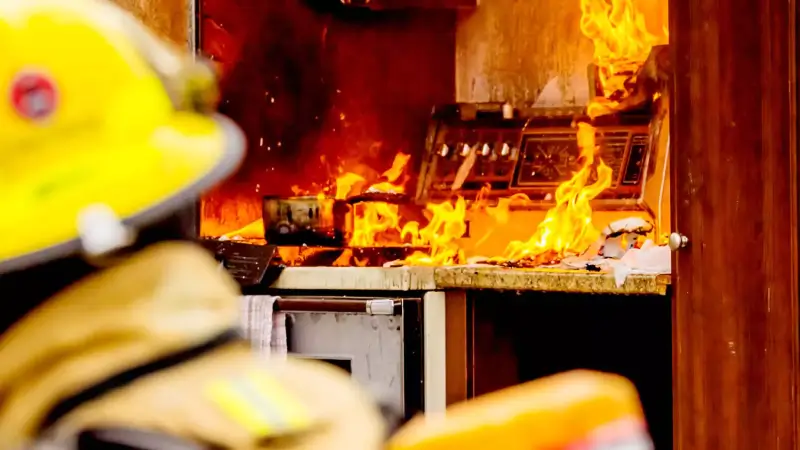
According to Rainbow Restoration, house fires pose significant risks to families and property.
|
Key House Fire Statistics:
- The leading cause of house fires is cooking.
- There are approximately 1.5 million residential fires each year.
- Property losses from fires total more than $48 billion annually.
- A quarter of fires occur on or in residential properties, and those fires account for three-quarters of all fire-related injuries.
- Thanksgiving accounts for the highest number of fires per day every year.
House fires can cause extensive damage to a property, resulting in billions of dollars in damage each year. Knowing and understanding house fire statistics can provide valuable insight into how common house fires are, their typical causes, ways to prevent them, and the costs of smoke and fire damage.
Table of Contents:
- Causes: What Are the Leading Causes of House Fires?
- Frequency: How Common Are House Fires?
- Location: Where Do Most House Fires Start?
- Damage: Economic Loss of House Fires
- Restoration: Recovering From a House Fire
- Fire Prevention Tips
- Call Rainbow Restoration® for Fire Damage Restoration
- House Fire FAQ
Methodology: The data in this article was sourced from various government and other official websites, including the United States Fire Administration (UFSA), the Federal Emergency Management Agency (FEMA), and the National Fire Protection Agency (NFPA). The data they collect is based on fires reported to local U.S. fire departments.
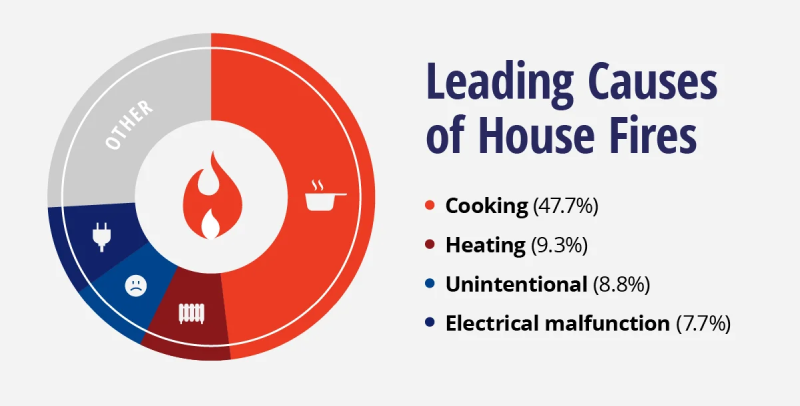
Causes: What Are the Leading Causes of House Fires?
House fires can cause significant damage to properties and belongings. Understanding the most frequent causes of these fires is crucial for preventing them. By identifying fire hazards and implementing preventative measures, the risk of fires can be reduced.
- The leading cause of house fires is cooking (47.7%), followed by heating (9.3%), unintentional or carelessness (8.8%), and electrical malfunction (7.7%). (FEMA)
- Leaving the room or not paying attention while cooking is the leading cause of cooking fires. (NFPA)
- Approximately 7% of residential fires are caused by candles, matches, or lighters. (NFPA)
- Only 5% of residential fires are caused by smoking and smoking materials. (NFPA)
- There’s an average of 150 Christmas tree-related fires every year. (NFPA)
- On average, 2.3 times more residential fires happen on Thanksgiving than any other day. (FEMA)
- There are more than 15,000 clothes dryer or washing machine fires every year. (NFPA)
Frequency: How Common Are House Fires?
The threat of a house fire can feel ever-present, but how common are they in reality? Prevention measures can and do greatly decrease the risk of house fires. However, millions still occur each year.
- Local fire departments in the United States respond to approximately 1.5 million fires each year. (NFPA)
- The overall number of residential fires is decreasing while the cost of damage is increasing. Data shows that between 2012 and 2022, the number of residential fires decreased by 4%, while the dollar loss associated with fires increased by 21%. (FEMA)
- Although cooking-related fires remain the leading cause of house fires, they’ve actually decreased in frequency by 7% between 2013 and 2022. (FEMA)
- First responders respond to fires approximately every 22 seconds in the United States. (NFPA)
- Apartment fires account for 5% of fires. (NFPA)
- Approximately 19% of fires occur in one- or two-bedroom family homes. (NFPA)
- The number of residential fires between 2021 and 2022 increased by 11.1%. (NFPA)
Location: Where Do Most House Fires Start?
The kitchen is the heart of the home and it's the most common battleground in the fight against fire. The reality is that a fire can start anywhere in the home, whether it’s due to faulty wiring or an accident. Knowing which areas of a home may be more prone to fire can help prevent future ones.
- More than 1 in 4 reported fires happen in home environments. (NFPA)
- Approximately 44% of residential fires begin in the kitchen. (NFPA)
- The majority of residential fires (21%) are reported between 5 and 8 p.m. (NFPA)
- Approximately 25% of fires occur in or on residential properties. (NFPA)
- A total of 35% of fires were structural, meaning they were in or on a building. (NFPA)
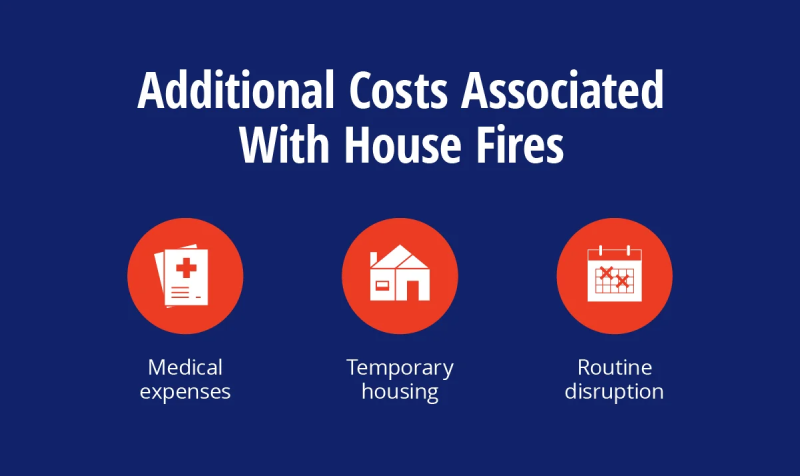
Damage: Economic Loss of House Fires
Fire damage costs Americans billions of dollars each year, from the actual cost of the damage to indirect costs.
- Property losses from fires total more than $48 billion a year, an all-time high for the last decade. (Insurance Information Institute)
- House fire damage is not just from the fire itself but also from smoke damage, heat, and the water used to put the fire out. (FEMA)
- A property may have broken windows and holes in the walls or ceiling after a fire. The fire department does this to help ventilate the fire and decrease the amount of long-term damage. (NCDOI)
- Besides the loss of property, other expenses include medical expenses, temporary housing, and any costs associated with the disruption to routine, such as missing work or school.
Restoration: Recovering From a House Fire
The aftermath of a house fire can be overwhelming. Some key facts about fire recovery include:
- It’s the property owner’s responsibility to secure the property after a fire to prevent further damage or theft. For help with this, call the restoration professionals at Rainbow Restoration.
- Occupants need to be careful of what they touch when returning to the property. The soot and dirty water left behind can be contaminated and potentially harmful. (FEMA)
- Any food exposed to heat, smoke, or soot should be thrown away. (American Red Cross)
- Food stored in the freezer with ice on it is safe, but otherwise, it needs to be disposed of. (American Red Cross)
- Avoid throwing away any damaged items to claim as a loss until after an insurance adjuster has visited and seen the damage. (American Red Cross)
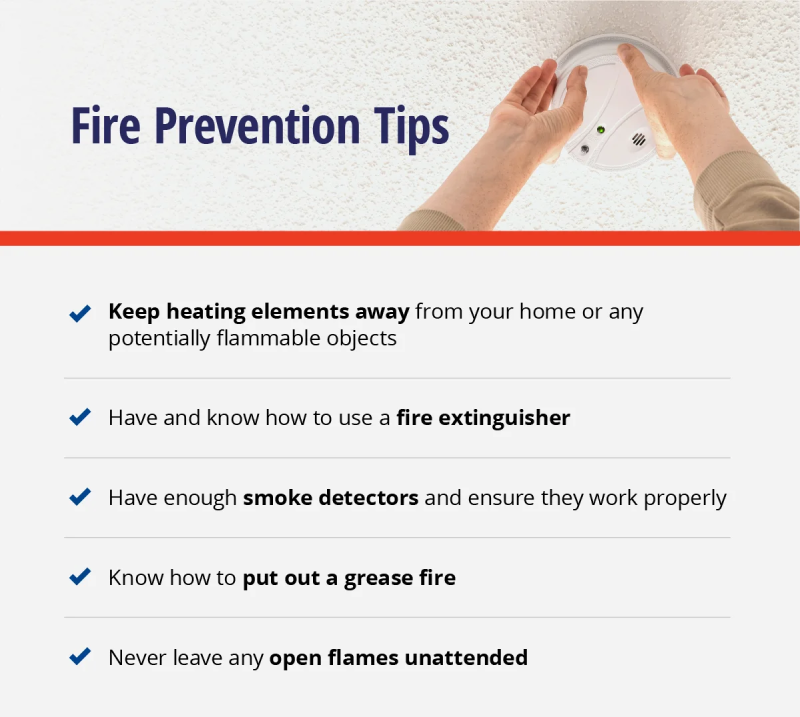
Fire Prevention Tips
The thought of a fire can be frightening, but the good news is that many fires are preventable.
- Put any outdoor heat elements, such as barbecues and fire pits, at a safe distance from the home and anything else potentially flammable. Avoid using them if the conditions are dry.
- Ensure a fire extinguisher is easily accessible. It should not be expired. Disposable fire extinguishers need to be replaced approximately every 10 years. All household members should know how to use it.
- Make sure there are an appropriate number of smoke detectors installed for the space and that their batteries work properly. Regulations require that homes have smoke detectors on every floor, in every sleeping area, and outside every sleeping area.
- Know how to put out a grease fire. For small grease fires, baking soda works. Larger ones have to be suffocated by covering the fire. Do not use water.
- Never leave any open flames unattended. This includes candles, fireplaces, and other open flames, even if it’s just for a few seconds.
Call Rainbow Restoration for Fire Damage Restoration
Professional fire damage restoration companies are trained to handle both fire damage and secondary damage caused by smoke and water. With our IICRC-certified teams and 24/7/365 services, Rainbow Restoration will help property owners recover as soon as possible. We provide professional fire damage restoration services you can trust, for both commercial and residential properties.
Call Rainbow Restoration to begin fire damage restoration.
This article is intended for general informational purposes only and may not be applicable to every situation. You are responsible for determining the proper course of action for your property. Services should be performed by licensed and experienced professionals. Rainbow Restoration is not responsible for any damages that occur as a result of this blog content or your actions. For the most accurate guidance, contact a Rainbow Restoration professional for a custom, on-site assessment.
House Fire FAQ
The service professionals at Rainbow Restoration have decades of experience with damage restoration after a house fire. We answer many questions every single day. Please reach out to us directly if you have any additional questions.
What Is the Main Cause of House Fires?
The leading cause of house fires is cooking, particularly people cooking and leaving their food unattended.
What Is the Likelihood of a House Fire?
Home structure fires are reported about every 88 seconds in the United States, which amounts to about 350,000 fires per year. While this sounds like a lot, it translates to a relatively low risk to individuals.
What Is the Most Common Day for House Fires?
Thanksgiving is the day with the most house fires in the United States.
Which State Has the Most House Fires?
There's no definitive answer to which state has the most house fires. Fire data is reported by local fire department responses, and population can skew the numbers. Some states might have a higher number simply because they have more people.
What Are the Odds of Your House Burning Down Twice?
While fire data doesn’t track individual houses but rather department responses, it’s extremely unlikely that a house would burn down twice. Unless the cause was some sort of unresolved electrical issue, continued carelessness, or foul play, the odds are it won’t happen twice.
How Hot Is a House Fire?
House fire temperatures can get as high as 1,500 degrees. The temperature will be highest near the ceiling and coolest on the ground (around 100 degrees), which is why it’s recommended to crawl to escape.
